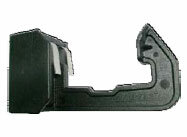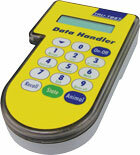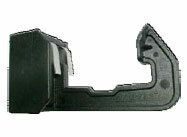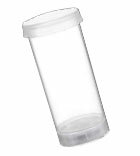Data Handler

- Portable device. Used to communicate via RF with the EMMs used in a herd test.
- Single unit. One Data Handler can work with a parlour full of EMMs.
- Accurate. Herd information is checked for accuracy as it’s entered, minimising errors.
- Communication and feedback. Can interface with a printer for fast feedback after a herd test as well as with a PC allowing two-way communication with the herd recording database, removing the need for manual data entry at the laboratory.
Data Interface Unit

- USB. Incorporates a BAFO USB interface unit so that the Tru-Test Data Handler can interface to laptops and PCs via a USB port.
- Versatile. The BAFO USB interface allows the Data Handler to interface with a wide range of laptops and PCs.
- Stable. The BAFO USB interface is exceptionally stable, enabling software updates and LinkTTEMM uploads and downloads on a wide range of laptops and PCs.
EMM Charging Clip

- Clips on. Positive location onto the EMM charging contacts.
- Designed for ease of use. There is no need to remove brackets to charge the EMM, making set-up much quicker and easier.
- Easy connection. 400 mm linking wires are included with the charging bracket so that up to 10 charging brackets can easily be linked to each other and to the power supply.
Sample Vials

- Tag Read. RFID tags have a unique serial number that can be read by the Tru-Test EMM and thus linked integrally to a cow and a sample. Laboratory readers are available that can read the information from vials in seconds.
- Tag Write. The Tru-Test EMM can write information to the tag such as the animal ID, milk yield and milking time. This can be used in the laboratory as a back-up to the data stored in the Data Handler, or the tag can be used as the main data carrier.
- Tag retention. The RFID vial tag is retained underneath the vial. It is not in contact with the milk. The vial can accomodate a variety of commonly available tag sizes. Should the vial become damaged, the RFID tag can be
- Read/Write Range. The read range for tags can vary and should be thoroughly tested with the Tru-Test EMM before committing to a type. Tru-Test can recommend tag brands.
- Memory. Memory size typically ranges from 256 bit to 10 kbit. 2 kbits is recommended if information is to be written to the tag. There is of course a price vs memory size trade-off.
- Ruggedness. Not all tags are made to withstand frequent washing and temperature changes. Tru-Test recommends laundry tags for this reason.
- Format. Tags come with a variety of data formats. The Tru-Test EMM may need to be configured for a particular format.




